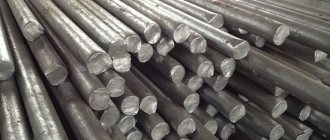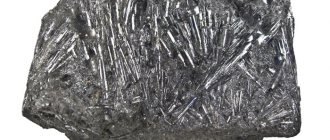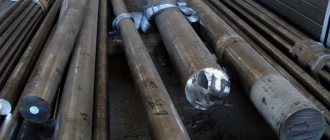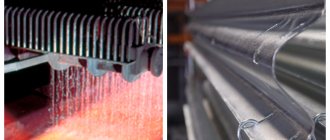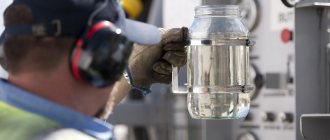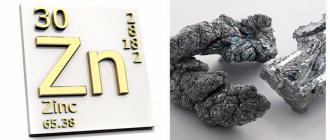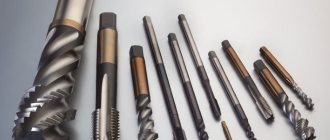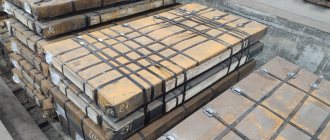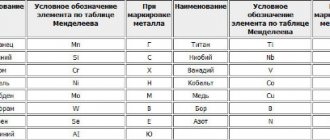Steel 38 (38-PV) Steel 20-KS Steel 20-KHS Steel 20K Steel 20kp Steel 20ps Steel 20YuA Steel 20YuChA (20YuCh) Steel 22ZhR Steel 22K Steel 25 Steel 25ps Steel 30 Steel 35 Steel 20 (20A; 20B) Steel 40 ( 40A) Steel 43 (43-PV) Steel 45 Steel 45T (45ST) Steel 50 Steel 54 (54pp) Steel 55 Steel 58 (55pp) Steel 60 Steel 60pp (60pp-PV) Steel 90 (BP5) Steel D Steel DB Steel E55 steel 18YUA Steel 11MTYUA Steel 11YUA Steel 12K Steel 15 (15A) Steel 15K Steel 15kp Steel 15ps Steel 15FYuA Steel 15YuA Steel 16GNMA Steel 16K Steel 18K Steel 18kp
Designations
| Name | Meaning |
| Designation GOST Cyrillic | 20YUCHA |
| Designation GOST Latin | 20JuChA |
| Translit | 20YuChA |
| By chemical elements | 20AlZr |
| Name | Meaning |
| Designation GOST Cyrillic | 20YuCh |
| Designation GOST Latin | 20JuCh |
| Translit | 20YuCh |
| By chemical elements | 20AlZr |
Hardening methods
Parts are hardened using the following methods:
- hardening production with one cooler is the process of lowering a heated part into a medium, where it must be left until completely cooled. Used when processing parts of simple shape, for the production of which carbon and alloy rolled products are used;
- Hardening of steels containing a high percentage of carbon is carried out in two environments using intermittent hardening. First, accelerated cooling is carried out (in water), and then gradual cooling (in oil);
- To heat treat a section of a part, jet hardening is performed by spraying it with a high-pressure stream of water. In this case, a steam jacket does not form and deep calcination is ensured. Conducted on HDTV installations;
- Cooling of the part, carried out at a temperature above the martensitic point, is carried out using step hardening. In this case, it is necessary to ensure conditions for compliance with the cooling and holding technology in this environment, so that all cross-sectional points of the part have the temperature created in the quenching bath. Then gradual cooling and hardening are performed, ensuring the transformation of austenite into martensite;
- during isothermal hardening, the steel is kept in a hardening medium for a period of time established by the technology for the isothermal transformation of austenite.
When performing tempering, which is one of the types of heat treatment, a stage of martensite decomposition and recrystallization occurs.
Carrying out the tempering operation makes it possible to obtain a material with plastic properties and reduce its fragility while maintaining strength indicators. For this purpose, the products are heated in the range from 150...260 0C to 370...650 0C and cooled slowly.
- Structural steel
- Tool steel
- Magnetic steel
Description
Steel 20YuChA is used : for the manufacture of pipes, bodies, bottoms, flat flanges and other parts operated in environments containing hydrogen sulfide and carbon dioxide at temperatures from -40 °C to +475 °C; parts of pipeline fittings with heat treatment; welded vessels of the gas and petrochemical industry; seamless hot-deformed oil and gas pipeline pipes with increased corrosion resistance and cold resistance, intended for use in oil and gas pipeline systems, technological field pipelines transporting oil and oil products, as well as in systems for maintaining reservoir pressure in oil production enterprises operating in environments containing hydrogen sulfide and carbon dioxide.
Note
The steel is resistant to corrosion cracking.
Heat treatment process
The heat treatment process is represented by main types, among which it is necessary to highlight:
- Annealing, including homogenization and normalization procedures, is performed to obtain a metal whose microstructure is uniform and grainy, with inclusions dissolved. The cooling that follows this operation is performed slowly, which helps prevent the appearance of martensite;
Hardening is carried out while maintaining a high level of cooling rate, which makes it possible to obtain martensitic structures. When determining the critical level of cooling rate required to perform hardening, brands and types of materials are taken into account;
- Tempering is required to remove stresses generated during hardening, providing a higher degree of ductility while simultaneously reducing strength properties;
- Normalization is carried out by heating the product to the austenite state, that is, 30...50 degrees above AC3, with further cooling in air;
- Precipitation hardening (or aging) is carried out if, after the annealing operation, the part is heated to a lower temperature level to produce hardening phase particles. In some cases, aging is performed in stages, using several temperature conditions to isolate strengthening agents in several types;
- Cold treatment.
Standards
| Name | Code | Standards |
| Thermal and thermochemical processing of metals | B04 | ST TsKBA 026-2005 |
| Long and shaped rolled products | B32 | TU 14-1-3332-82 |
| Sheets and strips | B23 | TU 14-1-3333-82 |
| Blanks. Blanks. Slabs | B31 | TU 14-1-4179-86, TU 14-1-3345-82 |
| Sheets and strips | B33 | TU 14-1-4853-90 |
| Steel pipes and connecting parts for them | B62 | TU 14-3-1652-89, TU 14-3-1600-89, TU 14-157-54-97, TU 14-162-14-96, TU 14-162-20-97, TU 14-3- 463-2005, TU 14-3Р-54-2001, TU 14-3-1745-90 |
| Metal forming. Forgings | B03 | TU 26-0303-1532-84 |
Quenching media
When performing hardening, in order to obtain the effect of supercooling austenite before martensitic transformation, an accelerated cooling procedure is required. Moreover, this must be done in the range of 650...400 0C, where austenite has properties of less stability and accelerated transformation into a mixture of ferrite-cementite composition occurs. At temperatures above 650 0C, a low rate of austenite transformation is observed, which allows the cooling process to be carried out in a measured mode, subject to constant monitoring of its progress.
The raw materials for the formation of quenching media can be water, oil, water-polymer media (Thermat), salt solutions with the following mechanism of action. When lowered into the quenching medium, a film forms from superheated steam around the surface of the product. The cooling procedure is carried out using a steam jacket and lasts a relatively long time. When a certain temperature is reached, set based on the components of the liquid, the steam jacket ruptures, the liquid begins to boil, passing on the surface of the product, and rapid cooling is achieved.
The slow boiling process occurs in several stages:
- film;
- bubbly;
- convective heat transfer. In this case, the phenomenon of a lower temperature level on the metal surface is observed in comparison with the boiling temperature of the liquid. Given the impossibility of boiling the liquid, cooling slows down.
Mechanical characteristics
| Section, mm | sТ|s0.2, MPa | σB, MPa | d5, % | kJ/m2, kJ/m2 | Brinell hardness, MPa | HRB |
| Seamless hot-deformed, heat-treated pipes in delivery condition according to TU 14-162-14-96 | ||||||
| 338-470 | 502-627 | ≥25 | — | — | ≤92 | |
| Pipe blank according to TU 14-1-4179-86 (heat-treated longitudinal samples) | ||||||
| — | ≥235 | ≥410 | ≥23 | ≥490 | ≤190 | — |
| Blanks for pipeline fittings according to ST TsKBA 026-2005. Hardening in air from 900-920 °C (holding time 2.5-4.0 hours depending on the thickness and weight of the workpiece). (KCU-40°C) | ||||||
| ≤180 | ≥235 | ≥412 | ≥23 | ≥490 | ≤190 | — |
| Long hot-rolled steel according to TU 14-1-3332-82. Normalization at 900-920 °C. KCU is indicated at -40°С (KCU-40°С) | ||||||
| Sample 15x15 | ≥235 | ≥412 | ≥23 | ≥490 | — | — |
| Thick plates (10-160 mm) as delivered (normalization or thermal improvement, KCU-40°C) | ||||||
| ≥235 | ≥410 | ≥23 | ≥480 | — | — | |
| Cold-deformed pipes Dн=25-89 and seamless hot-deformed pipes as delivered (normalized) according to TU 14-3-1745-90, TU 14-3R-54-2001. Heat-treated, as delivered (KCU-40°С) | ||||||
| 245-382 | ≥412 | ≥23 | ≥490 | ≤190 | — | |
Chemical composition
Chemical composition in%
| NTD for steel 20YuCh | C | S | P | Mn | Cr | Si | Ni | N | Cu | Ca | As | Al |
| TU 14-1-4853-90 | 0,16-0,22 | ≤0,005 | ≤0,020 | 0,50-0,80 | — | 0,17-0,37 | ≤0,25 | ≤0,012 | ≤0,25 | 0,001-0,010 | ≤0,08 | 0,03-0,10 |
| TU 14-1-4179-86 | 0,16-0,22 | ≤0,012 | ≤0,020 | 0,50-0,80 | ≤0,30 | 0,17-0,37 | ≤0,40 | ≤0,012 | — | — | — | 0,03-0,10 |
| TU 14-3-1652-89 | 0,16-0,22 | ≤0,012 | ≤0,020 | 0,50-0,80 | — | 0,17-0,37 | ≤0,40 | ≤0,012 | — | — | — | 0,03-0,10 |
| TU 14-3R-54-2001 | 0,16-0,22 | ≤0,012 | ≤0,020 | 0,50-0,80 | ≤0,25 | 0,17-0,37 | ≤0,40 | ≤0,012 | ≤0,30 | — | — | 0,03-0,10 |
| TU 14-162-14-96 | 0,17-0,22 | ≤0,015 | ≤0,015 | 0,50-0,65 | ≤0,25 | 0,17-0,37 | ≤0,25 | ≤0,012 | ≤0,25 | — | — | 0,03-0,05 |
| TU 14-3-1745-90 | 0,16-0,22 | ≤0,012 | ≤0,020 | 0,50-0,80 | ≤0,25 | 0,17-0,37 | ≤0,40 | ≤0,012 | — | — | — | 0,03-0,10 |
Fe is the basis.
According to TU 14-1-4853-90, TU 14-3-1652-89 and TU 14-1-4179-86, the chemical composition is given for steel 20YuCh. In order to globularize sulfide non-metallic inclusions, rare earth metals (titanium, calcium, zirconium) are introduced into deoxidized steel at the rate of 0.7 kg/t. The content of rare earth metals in steel is not an acceptance indicator, but is controlled and included in the quality document. The technological additive silicocalcium is introduced into the steel in order to obtain 0.001-0.010% calcium in the finished rolled product.
According to TU 14-3-1652-89 and TU 14-1-4179-86, the content of other elements is in accordance with GOST 1050.
According to TU 14-162-14-96, the chemical composition is given for steel 20YuChA. In steel, deviations are allowed in the content of carbon (-0.020%), aluminum (±0.010%), manganese (+0.15%), sulfur (+0.005%), phosphorus (+0.005%). In order to globulate sulfide non-metallic inclusions, cerium is introduced into the deoxidized steel based on the cerium content in the steel of 0.050%, the content of which is not controlled, and its calculated value is entered into the certificate. In order to increase strength properties, it is allowed to introduce vanadium into steel in an amount of up to 0.050%.
According to TU 14-3-1745-90, TU 14-3R-54-2001, the chemical composition is given for 20YuCh steel. Residual content of other elements in accordance with GOST 1050. Deviation in the content of carbon -0.020%, aluminum +0.010%, other elements in accordance with GOST 1050. One or more modifiers from the group: rare earth metals, titanium, calcium, zirconium in amounts up to 0.07% each. The content of these elements in steel is not an acceptance indicator, but is included in the quality document.
Description of mechanical symbols
| Name | Description |
| Section | Section |
| sT|s0.2 | Yield strength or proportional limit with tolerance for permanent deformation - 0.2% |
| σB | Short-term strength limit |
| d5 | Elongation after break |
| kJ/m2 | Impact strength |
| HRB | Rockwell hardness (steel indenter, spherical) |
Quenching and high tempering (improvement)
For steels, a hardening process is used during hardening by rapid cooling performed in air, oil or water. This procedure contributes to the creation of a nonequilibrium martensite structure. The hardening operation allows steel to obtain such characteristics as high hardness, low levels of ductility and toughness. For example, in steel 40ХНМА (SAE 4340), after the hardening procedure has been carried out, the hardness index is more than 50 HRC, so the material cannot be used due to its brittleness and susceptibility to destruction. Carrying out the next tempering, which consists of operations such as heating to 450 C... 500 0C and maintaining at this temperature, allows you to reduce internal stresses, taking into account such phenomena as the decomposition of martensite and changes in lattice distances. At the same time, the level of hardness with an additional index of 45...48 HRC is slightly reduced. The correction procedure is performed for steel containing 0.3...0.6% carbon. Annealing is a type of heat treatment and consists of heating to a set temperature, holding and cooling. In this case, renewal, recrystallization and homogenization of the metal occurs. The purpose of the operation is to reduce the level of hardness, which makes it possible to increase the workability of the metal, improve the structural composition and achieve a greater degree of homogeneity of the metal, and relieve stress inside the lattice.
Technological properties
| Name | Meaning |
| Macrostructure and contamination | According to TU 14-1-3332-82, non-metallic inclusions must have a globular shape and a score of no more than 4.0 “b” on the “SN” scale according to GOST 1778. The presence of individual sulfides of an elongated shape is allowed with a ratio of maximum to minimum size of more than 3, with a score of not more than 1 “b” of the “C” scale according to GOST 1778. Metal contamination with non-metallic inclusions should not exceed an average score of 2.5; the maximum is 3.0. |
| Microstructure | According to TU 14-3-1745-90, TU 14-3R-54-2001, the banding of the ferrite-pearlite structure of h/d pipes should not exceed 4.0 points according to GOST 5640. The grain size of the pipe metal in the delivered state should not be larger than 7 points, individual grains are allowed 6 points. |
| Corrosion resistance | According to TU 14-3-1745-90, the threshold value of hydrogen sulfide corrosion cracking must be at least 147 MPa (15 kgf/mm2). The steel is resistant to corrosion cracking. |
Material 20YuCh Chelyabinsk
Not a single production can operate without steel, be it heavy engineering or the manufacture of household electrical appliances. There are many brands of this product, as well as a large number of dispensing forms. Our company sells 20YuCh material in large quantities and with a minimal margin. To clarify the properties and characteristics of a particular brand, you can contact the company’s managers.
Like all products, 20YuCh material is purchased from leading manufacturers. Therefore, we are ready to provide a quality guarantee with full responsibility. The minimum number of intermediaries determines the low cost. Coupled with fast delivery, this enables our business partners to conduct stable and mutually beneficial cooperation.
In addition to tempering, in the form of one or another part (blank), our company carries out metal processing. All events undergo strict control for compliance with GOST and rules. The specialists of our company carry out such work as galvanizing, creating parts according to customer drawings, producing castings, manufacturing various profiles and much more.
Having the latest equipment and vast experience in our arsenal, we can offer product testing for a number of parameters, such as strength characteristics, chemical composition, alloy purity, and so on.
Each buyer is offered a huge range of products in various formats, as well as current services and works. To quickly understand and choose a product that meets your needs, you need to contact the company manager and receive detailed information on all issues of interest.
